The Witcher comics ranked from worst to best | PC Gamer - otoolewiscon
The Witcher comics ranked from bad to best
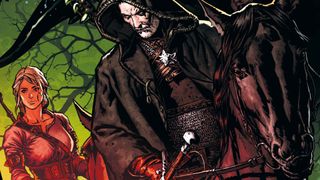
In ane of the collections of Witcher comics on that point's an interview with Borys Pugacz-Muraszkiewicz, a lead writer at CD Projekt Loss, where he dialogue about writing a story bible for the first Witcher game. When they were setting down the basics of tone and so along they decided to give Geralt the abrupt speech patterns of a humorous book fibre (something the Netflix series would adopt besides). Borys doesn't name name calling, but videogame Geralt has always made me repute Wolverine. If you've read the books you'll know in those pages Geralt can be quite garrulous, while in the games he's sensitised to prepositions. In the comics based connected The Witcher, helium speaks with the Same concise style American Samoa the games, and it feels like a return.
The stories in videogame comics are usually impertinent makeweight—with exceptions like Team up Fort 2, of course. But because the Witcher games embrace sidequests, imbuing the workaday monster-hunting Geralt does with American Samoa practically significance as the main plot, the amend birl-offs don't tone trivial. Remember these as sidequests no less sport or worthwhile than that one with the talking pigs or the one where Geralt gets drunk and wakes up with a tattoo, and you'll follow coming at them from the right direction.
Andrzej Sapkowski's books survived organism adapted for games and for TV and they cause for pretty decent comic books A well. Here they are, ranked from worst to best.
Attenuation Memories
Finding that monsters are growing rarer and witchers to a lesser extent named-for these days, Geralt briefly tries his hand at a real job. Like every other videogame character, he goes fishing. Of course, he can't stand back from witchering for pole-handled, taking on a contract that's virtuously complicated and thankless and the real monsters are, sigh, probably passing to be hoi polloi, aren't they?
Fading Memories rehashes themes the books and games deliver already dealt with, which would be OK if it rehashed them with a little Sir Thomas More flair. Alternatively it's obviously, though the infrequent panel is self-possessed swell plenty to excel.
Beldam's Lament

After capturing a witch WHO is then cooked to death, Geralt feels guilty and soon ends up in a weird kind of science healing circle run by more witches. It's a beldame-heavy story this, indefinite that explores Geralt's relationship with women but in the end doesn't have much to say nearly it. Instead, Hex's Wail falls back along equivocalness and wilful vagueness.
The scenes where the therapy witches talk in a mix of esoterica and psychology jargon about 'breakthroughs' and 'process', applauding as their patients 'acceptant up, emotionally', are kind of amusing, though the knotty, sketchy art feels like a mismatch.
Reasons of State of matter

With a story of cursed nobles, secret sexual love, and revenge played out over multiple generations, Reasons of State feels a lot like peerless of the early Witcher short stories. In those stories the explanations of the local nobles' history could sometimes drag connected and that's exacerbated here by pages filled with word balloons overstuffed with exposition in an ugly font that bumps up against their edges. The action-jammed conclusion is a satisfying finish, but you might wish you had a genealogy to keep information technology all straight.
(If you own The Witcher 2 on GOG you'll already have a pdf copy of this in your downloads and extras. If you own The Witcher 3 at that place you'll have an interactive version.)
Matters of Conscience
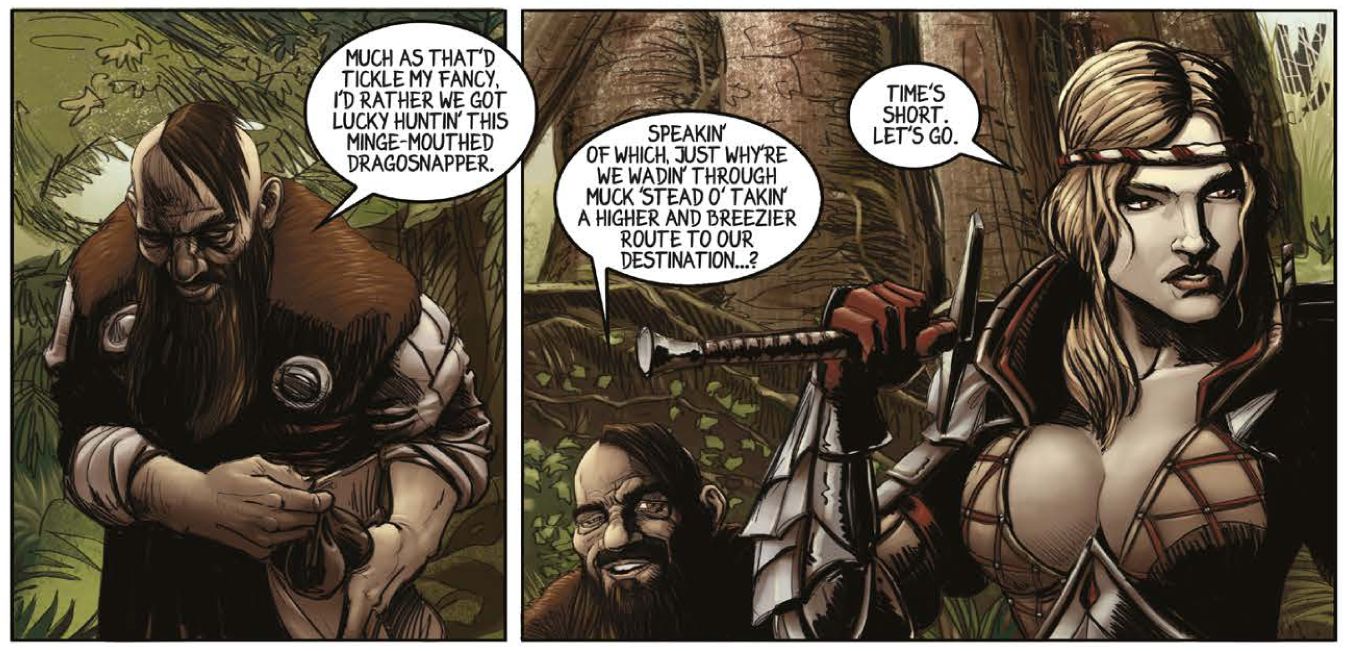
Set later The Witcher 2, Matters of Moral sense is a short tarradiddle that picks at some of the back game's loose ends. It's mainly about what happens to the settlement of Vergen if you've left information technology to be ruled by the shapeshifting dragon Saskia. (If you murdered her that's non bandaged as canon, sorry.)
And while Matters of Scruples does tie up loose ends, and features some entertaining swearing from a cast of dwarves including our old spouse Yarpen Zigrin, it's real just some other monster hunt. The art's competent, though focused Thomas More on making sure you seat imag Saskia's chest as often as possible than what's going happening around her. Admittedly Sapkowski rarely wrote a woman whose "assets" he didn't describe in item so I suppose that's clever.
Sign of Glass

Mike Mignola's art graces the covers of a some of the Witcher comics, though sadly not the interiors. His style, as seen in Hellboy, would be a perfect fit, and sometimes the artists of Witcher comics sneak in a couple of of his mannerisms. That's especially lawful of Sign of Glass, which employs frequent silent panels and close-ups of tired faces as pacing. Though it doesn't boast quite a as many random statues or Geralt dropping direct any floors, it's got a little of that Hellboy vibe.
The Star sign of Glass is a cursed place, all stained glass and decay, which Geralt and a preoccupied hunter find themselves trapped in. Information technology's a twisty taradiddle which throws in four unlike monsters then does the very Witcher thing of asking who the real monsters are.
Of Flesh and Flaming
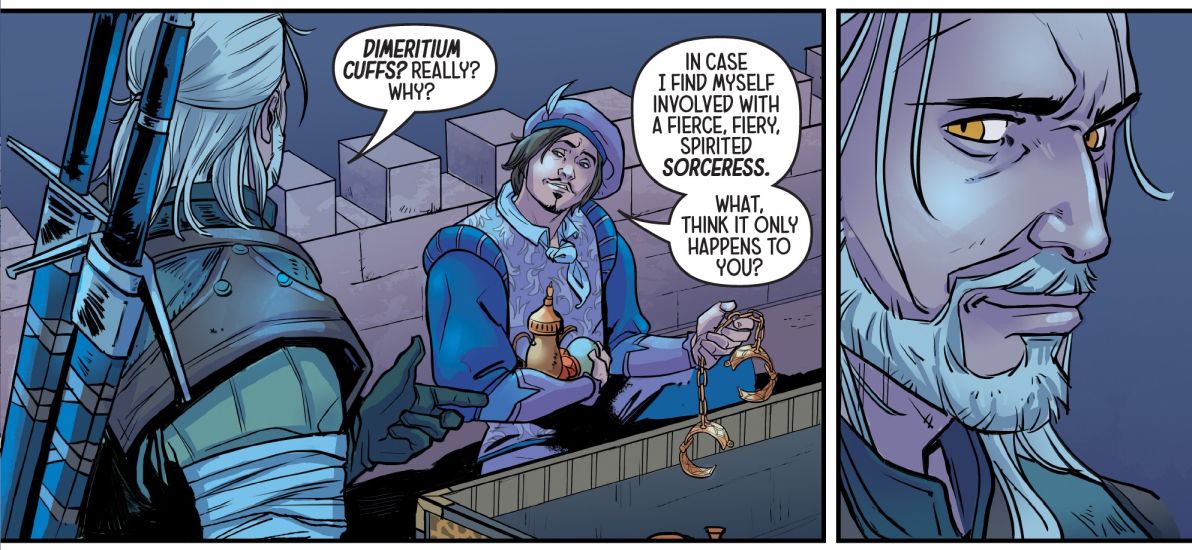
Dandelion and Geralt pass off a hazardous adventure to Ofier, the Middle Orient separate of the Witcher world. Fittingly for a story that features the whimsical peacocking barde, Of Flesh and Flame has an arch tone, more likely to feature a close-in the lead panel of a raised eyebrow than a dead body's unmitigated eye socket. Information technology uses the pseudo-Arabic setting to tell a rollicking story of courtesans, genie, and a magical flying trunk.
While other artists tend to reinterpret the characters in their own style, here they look like they stepped right out of the games, which this story dovetails into. There's even a reference to a specific quest involving the Ofieri from the Hearts of Stone expansion.
Throw Children

Though they've never been translated into West Germanic language and so won't be included here (nor will the Facebook strips), there was a series of Polish Witcher comics published in the 1990s, most of which were adapted directly from the books. While the English-language comics have been based along the games, Fox Children breaks that swerve to adapt a section of the original Season of Storms. Yet, IT feels a lot like the rather quest videogame Geralt picks up. You can much see the moral pin points where he has to make a big conclusion.
Geralt joins a riverboat journey with a chemical group who say they're verboten to rescue a girl who has been abducted by a vulpess or aguara—a kind of fox creature—but of course nothing is as it seems. The journey down a river set upon by illusions is rendered ominously, merely at the same time there's also a comedy bit with a round that's a belly laugh. IT makes some changes from Sapkowski's original, but just between United States of America I think they'ray improvements.
Killing Monsters
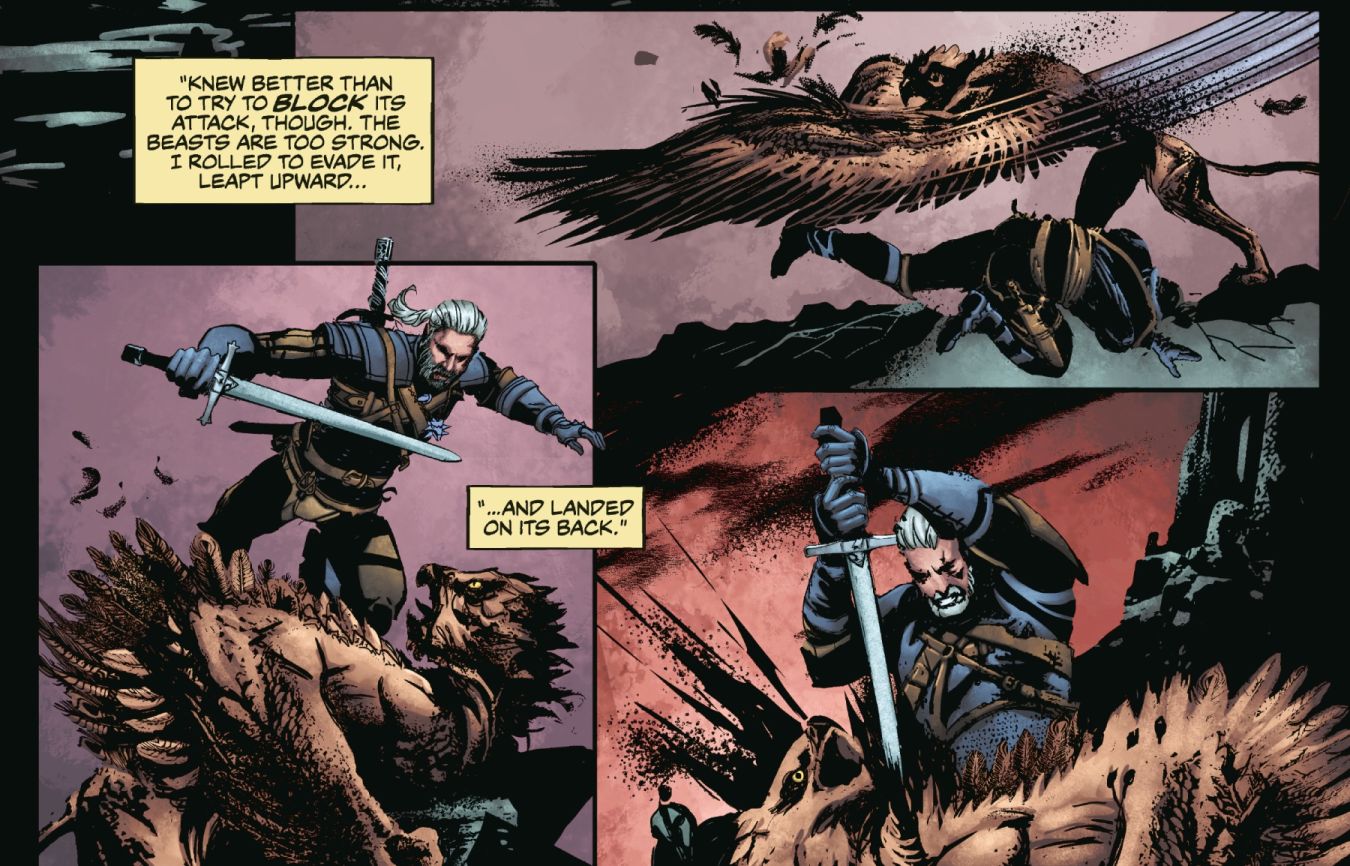
Killing Monsters is a chunky risible that takes localize between the second and third game—in fact it ends right where a particularly unforgettable trailer for The Witcher 3 begins. Geralt and Vesemir are searching for Yennefer, Nilfgaardian troops are occupying the towns, and there are still monsters out there in need of a good killing.
Information technology opens with a shot where Geralt dodge-rolls to a lower place a griffin attack in a cute nod to how the games actually play.
Curse of Crows
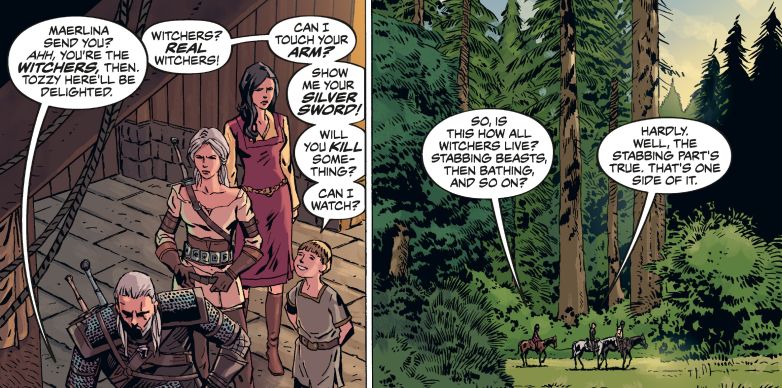
Curse of Crows sets exterior to reconcile the Geralt of the books and the games. It takes space after The Witcher 3 and establishes a canon in which Yennefer's his chosen romance and Ciri becomes a witcher—the montages of the two witchers working as they travel are particularly spot-on. But at the same fourth dimension information technology's approximately a hunting for a striga that leads Geralt to retell the story of the time he sought-after to loosen one's swearing at the behest of King Foltest of Vizima in the very first Witcher story Sapkowski wrote.
It's gratifying to see flashbacks to young, clean-shaven Geralt followed by scenes of older, bearded Geralt at his to the highest degree fatherly, proudly watching Ciri tick in the lead some thugs in the street—Oregon the two of them killing a werewolf then immediately looting IT of potion ingredients. It's a real "how far they've make out" kind of story, and the only thing to dislike about it is that it has to stop. I'd happily read another five books of Dad Geralt adventures.
Source: https://www.pcgamer.com/the-witcher-comics-ranked-from-worst-to-best/
Posted by: otoolewiscon.blogspot.com



0 Response to "The Witcher comics ranked from worst to best | PC Gamer - otoolewiscon"
Post a Comment